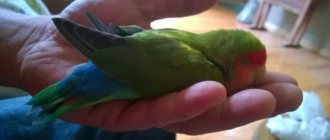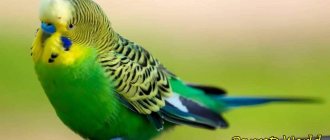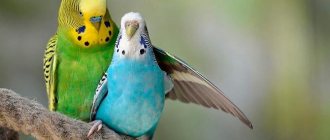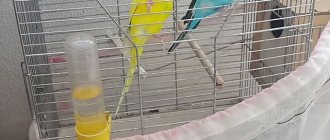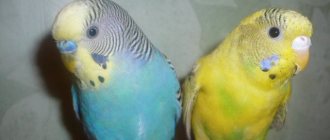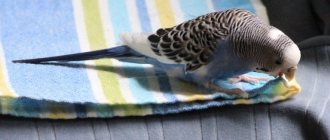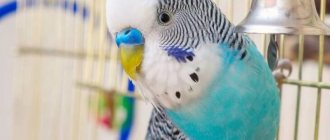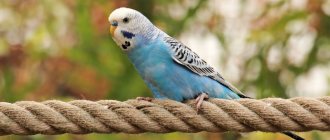The tick mite (lat. Syringophilus bipectinatus) is a parasitic disease also known under another name – syringophilosis. If the parrot is not given the necessary assistance in recovery in time, the consequences may not be the best. Syringophilosis is treated quite easily, the main thing is to carefully read the treatment and strictly follow all the instructions.
Trombidiform feather mites parasitize in the cavities of the tail, contour and flight feathers. They have an elongated body (about 1 mm) of yellowish or brown color. They live in colonies of up to 100 individuals in one feather. The feathers enter the feathers through channels that connect the feathers and the body of the bird.
As a result of their vital activity, they destroy the internal structure of the base of the feather, which causes inflammation of the area around the feather. Most often, outbreaks of infection occur in spring and summer; infections occur less frequently in autumn and winter.
They feed on lymph and exudate, so new feathers are affected first. Females lay eggs at the base of the feather, from which larvae then emerge.
Symptoms
Most often, young birds that have not yet matured are susceptible to the disease.
Some time after infection, the parrot's large feathers begin to break off and fall out. This usually starts to happen in the tail area. Infected feathers change their appearance: they become dull, change shape, and the edge of the feather turns brown. Exposed areas of red skin may appear.
Mites can cause severe itching in parrots, causing them to scratch constantly. In areas most affected by parasites, birds can pluck their feathers and scratch their skin until they bleed. Sometimes, even after recovery, the habit of self-plucking may remain - the bird will need to be weaned from it.
When infected, the overall vital activity and immunity of the body decreases. This increases the risk of contracting other diseases. Young chicks grow slowly and lose weight. Problems may arise during laying. Due to constant itching, the bird cannot rest normally at night.
Parasites reproduce quite quickly and can live for some time outside the body of parrots. Ticks are not dangerous to humans.
The diagnosis is made according to the previously described signs by comparing the feathers of a known healthy parrot and randomly dropped feathers of a presumably sick parrot. The feather edge of a sick bird is not transparent and is filled with a yellow-brown mass.
To make an accurate diagnosis, you need to contact an ornithologist at a veterinary clinic.
Symptoms
Signs of tick infestation are divided into general, which are characteristic of all types of parasites, and individual, inherent in each individual species.
General symptoms when parrots are infected with mites:
- apathy, lethargy;
- poor appetite or lack thereof. This is due to beak deformation;
- peeling of the skin in bald areas;
- itching, in which the bird can peck at the skin or pull out feathers.
Symptoms characteristic of each type of parasite separately:
- Scabies mite: appearance of growths.
- Loss of plumage, in which the feather shaft remains light, is characteristic of a feather pest.
- If the feather shaft is black, this is a tick on a budgerigar.
- Difficulty breathing, coughing, sneezing indicate the appearance of a tracheal pest. A change or loss of a pet's voice is the first symptom of this infection. The tracheal mite in the budgerigar causes frequent swallowing and breathing with an open beak, during which characteristic clicking sounds are heard.
How to detect the presence of scabies mites:
- Using a magnifying glass, inspect the beak and the area around it. If the skin and bone tissue are deformed, growths have appeared in the corners of the beak, and the beak itself is everted or turned to the side - these are symptoms of damage.
- The next sign is irritation and redness of the eyes, the appearance of growths in their corners.
- The claws on the paws are deformed or completely absent, the skin is changed, peeling, and covered with dense growths.
- A gray coating appears on the cloaca.
Each of these signs indicates problems with your pet's health. Urgent measures must be taken to treat the bird.
Sources
Usually, budgerigars become infected with the parrot mite during contact with sick individuals.
But besides this, there are several other sources of infection:
- branches and greenery brought from the street and not properly processed;
- purchased cages or accessories that were not processed correctly;
- cheap, low-quality feed;
- regular stress;
- a disease that already exists in the bird, occurring in a latent form.
In birds with good immunity, the disease can occur in a latent form. This is not dangerous, since the body has enough strength to cope with the disease. With a poor diet, errors in maintenance, and also in combination with other diseases, ticks can begin to actively reproduce.
Why are ticks dangerous?
There are different types of mites on parrots, and they each cause harm to the body in their own way. Some are characterized by loss of feathers, others change the condition of the skin. The presence of certain types of pests disrupts the functioning of internal organs. Common symptoms include weight loss, decreased activity, and loss of interest in entertainment. All these diseases are contagious. All birds are susceptible to them, regardless of species, gender and age.
Attention! Bird mites are not dangerous to humans.
Prevention
By following these simple tips, you can minimize the likelihood of your parrot becoming infected with a tick mite:
- varied, proper, nutritious nutrition;
- branded, high-quality food;
- maintaining hygiene, daily routine and weekly complete cleaning of the cage;
- treating new accessories or cages in the correct way;
- daily flights;
- daily live communication;
- lack of stress;
- no contact with any birds that have not undergone quarantine.
Methods of infection
Scabies mites appear in parrots when infected through contact . This happens when a healthy bird comes into close contact with an infected one.
Often the disease develops when using a poorly sanitized cage that has already been used before. Sometimes an already infected parrot is bought at a pet store, completely unaware of it.
Tracheal mites pass from one bird to another during mutual feeding. Parents often infect their chicks. And if there is a sneezing or coughing parrot nearby, then a respiratory route of infection cannot be ruled out. Sheepskin and feather mites get on the parrot's body through contact.
Sometimes overly vigilant owners perceive black dots on the head as a sign of infection. But in reality, these are just stumps growing during molting, so there is no need to panic.
Required funds
To treat the affected areas, purchase one of the following medications:
- frontline spray (spray, not drops);
- otodectin 0.1% ivermectin solution;
- chamomile (if nothing else is found).
Chamomile infusion
If you were unable to find these drugs, you can use others:
- arpalite;
- insectol;
- celandine spray.
Unfortunately, I have no experience in treatment with medications from the second list, so you will not find information about treatment with them here.
To strengthen your parrot's immunity:
- gamavit (required);
- catozal (optional);
- allowed vitamins.
Gamavit
Due to the high cost of catozal, it is not necessary to buy it. At the veterinary pharmacy, you can ask to draw a portion of catosal into an insulin syringe and buy only that, and not the whole bottle.
To treat the cage and perches, one of the preparations:
- butox;
- neostomozan;
- ecocide S.
The best option would be butox. The weakest of these three drugs is Ecocide S.
These drugs are very toxic, so it is necessary to wash the cage very carefully after treatment.
Additional accessories:
- quarantine cage (or disposable boxes with air holes);
- plastic perches;
- flower spray - atomizer;
- cotton buds;
- syringe.
Knemidocoptosis
This is a disease caused by the scabies mite. It is easy to recognize, as there are a number of symptoms characteristic of this pathological condition.
Symptoms and danger of infection
With knemidocoptosis, death is also possible, which is due to the general neglected state of the outer integument. You need to pay attention to the symptoms:
- a change in the shape of the beak, a deterioration in its appearance: growths appear, the eyes become watery, in these areas you can also notice a change in the structure of the outer shell, redness appears;
- the subcutaneous mite lives in the structure of the epidermis, feeds on tissue fluid, therefore peeling of the bird’s skin is observed due to increased dryness;
- you can also see a change in the properties of the outer shell of the paws;
- it is noticeable that the subcutaneous mite in the parrot provokes itching;
- the general condition of the bird is lethargic, apathetic, and changes in behavior cannot be noticed immediately, it all depends on the degree of damage to the outer integument;
- loss of appetite - this is caused by two reasons: deterioration of the beak, as well as baldness, the appearance of scabs, growths, irritation and itching;
- the skin is injured in places where the parrot tried to scratch the outer integument.
Separately, some signs characteristic of the development of diseases caused by various pests are noted:
- parrot mites: feathers begin to fall out, while their shafts become darkened; at the initial stage of development, you can see black areas on some feathers;
- tracheal parasite - provokes breathing problems, shortness of breath may appear, the bird begins to sneeze and cough, and these symptoms are accompanied by the release of a large amount of mucus;
- feather pests: the symptoms in this case are similar to the symptoms that appear when a bird is infected with common pests, but light-colored feather shafts can be noticed.
Knemidocoptic mange in a parrot
Stages of the disease
It must be remembered that treating a parrot for ticks at home can be carried out at the initial stage of development of the disease. In this case, symptoms can be relieved in a short period of time. The treatment is also quite simple, it becomes possible to quickly restore the outer skin. The main stages of knemidocoptosis:
- Initial: the activity of ticks has not yet increased to a high level, which does not allow them to be detected, since the symptoms are still absent or are quite weak, so the signs can be mistaken for manifestations of other, less dangerous diseases. In addition, the incubation period lasts for 4 months. This means that the first signs can be seen no earlier than it ends.
- Mild: the first more obvious manifestations are noticeable. They are already visible not only to the breeder (due to extensive experience), but also to the amateur. In this case, changes can be noticed in the area of the cere and paws. The structure of the outer integument changes, and growths form. They are distinguished by a light shade, which makes such formations look like lime deposits. Traces of peeling of the outer integument appeared. At the same time, the bird begins to stand on one leg for a long time. This helps her clean the affected areas with her beak.
- Average. You can see large areas where the tick parasitizes. The pest is simultaneously active in the area of the limbs, beak, organs of vision and most of the body. Clear changes in the shape of the beak are visible, which is due to the developing process of formation of growths. This does not allow the bird to eat properly.
- Heavy. This stage is rarely diagnosed in parrots, as it is usually a consequence of an indifferent attitude towards the fate of the bird. Symptoms: almost complete baldness, many growths are visible on the skin, the beak is severely deformed. The bird is exhausted because it has stopped feeding. Complications include loss of limbs due to inflammation in the joints, as well as death.
Knemidocoptosis - severe stage
General rules of treatment
Syringophilosis infects everything the bird has come into contact with; for this reason, it is prohibited to let it out of the cage during the treatment period. All wooden objects and toys, as well as mineral stones, are thrown away during the treatment period. The mineral stone can be divided into several portions and a new piece of stone can be placed every day. In the evening this piece must be thrown away. During the treatment period, the feeder with the mineral mixture is removed. The mineral mixture is poured into the feeder with the grain mixture, a pinch at a time.
The night cloak cannot be used either. Boil it and put it away until it is completely cured.
Before the procedure, prepare everything you need in advance. Always start the procedure with the same words. To let the parrot know what awaits him. That everything will end soon and nothing will happen to him. That you are a source of trouble only during the procedure. That at other times you still remain a source of protection, warmth, affection, food and games.
If there are two parrots in a cage, and you find symptoms in one, most likely the second one has also been infected. For a more accurate diagnosis, consult an ornithologist.
If only one bird is sick and you have three cages, treat the healthy parrot (one time) and the third cage according to the method described below and place it in this cage. In the future, when processing a sick parrot (second parrot), you will use the first two cells.
If you only have 2 cages, then you can keep a sick and healthy bird together. At the same time, treat a healthy parrot twice as often. If suddenly, after seating, one of the parrots refuses to eat, then we act in exactly the same way - we keep them together, and we process a healthy parrot half as often.
How often does shedding occur?
In healthy birds, like their relatives in the wild, the process of changing plumage occurs 2-3 times a year. Natural molting in budgerigars, when properly cared for, occurs almost unnoticed and does not cause any harm to your pets. At this time, parrots retain a good appetite, their inherent curiosity and mobility.
Unfortunately, a parrot can also experience shock molting - loss of plumage due to stress. Unlike the natural process, the bird will lose feathers quickly and very unevenly. Feathers fall out in whole bunches, and areas of completely bare skin are noticeable on the body. During this period, your pet's thermoregulation is impaired, so monitoring the temperature in the room with the cage is important. It is necessary not to overheat, but also not to overcool the bird.
Parrot treatment
Catch the parrot in the twilight. Read on for information on how to properly hold a parrot in your hand.
Frontline spray. Spray the tip of the cotton swab several times to thoroughly wet the cotton. Apply it to the skin under the feathers on the back of the head, spreading the feathers and under the wings. Try not to touch the feathers. After a short period of time, the medicine will be absorbed into the skin and gradually spread evenly throughout the body. The medicine will remain in the parrot's body for 2 to 3 weeks. During this time, all parasites will die.
Carry out the procedure once every 5 days. Only 4-5 procedures. Treatment lasts about a month.
Otodectin 0.1% ivermectin solution. 1 drop on the scalp. Try not to get on the feathers.
Carry out the procedure once every 8 days. Only 3-4 procedures.
Pharmaceutical camomile. If your wavy loves to swim, you can offer him baths with chamomile infusion.
Stages of the disease
A tick in a parrot is not immediately detected. Knemidocoptosis has four stages:
- Initial. There are no symptoms, but pathogens are already in the body;
- Easy. When examining the bird, bumps are found on the skin, the structure changes, and the pores expand. Peeling, plaque on the beak and wax, thinning of feathers;
- Average. The itching is very uncomfortable. The bird bites its legs, scratches its beak, gnaws and plucks feathers. Due to beak deformation, it does not take food. The parrot's legs are covered with growths, scabs hang around the eyes;
- Heavy. The feathers have already partially fallen out. The beak is bent, cracked, and there are bleeding wounds in the corners. A thick layer of epithelium has grown on the cere, covering the nostrils. This is an extremely dangerous condition when the bird can die any day now.
Treatment of cage and accessories
The infected cage, plastic toys and plastic poles are treated once every 5-7 days.
treatment with butox or neostomozan: dilute half the ampoule into 1 liter of warm water; treatment with ecocide C: dilute 10 g (1/5 sachet) per 1 liter of warm water. Spray everything thoroughly with a spray bottle in the bath. Leave for 2 hours. Then rinse everything very thoroughly with water, scald with boiling water, and dry. Rinse water bowls and feeders well with water, pour boiling water over them and dry. We return the bird to the cage. We do the same with the quarantine cage.
Methods for diagnosing molluscum contagiosum
Molluscum contagiosum can be confused with manifestations of other diseases, including serious ones such as syphilis or cancer. Also, the activity of the molluscum contagiosum virus increases with a decrease in immunity, so in 20% of cases molluscum contagiosum accompanies HIV infection. This means that when rashes appear that correspond to the description of molluscum contagiosum, a medical examination is required to rule out such options.
When contacting a dermatologist, the doctor will examine the patient, make a diagnosis and suggest a treatment method.
Inspection
In most cases, the diagnosis of molluscum contagiosum is made by a dermatologist based on the results of an examination of the patient.
PCR diagnostics
Since HIV often accompanies molluscum contagiosum, PCR diagnostics for HIV can be prescribed.
More information about the diagnostic method
Serological blood test
When molluscum contagiosum is detected in adults, a serological blood test is prescribed to identify sexually transmitted infections (hepatitis B and C, HIV, syphilis, etc.).
More information about the diagnostic method
Sign up for diagnostics To accurately diagnose the disease, make an appointment with specialists from the Family Doctor network.
Oral medications
From the beginning of the course of treatment, the parrot is given Gamavit (and, if available, Catozal). These drugs support the immune system and rid the body of toxins (if the ointment gets inside).
gamavit: 0.5 ml per 50 ml of water, in a drinking bowl, course 7 days; catozal: 0.2 ml per 50 ml of water, together with Gamavit, course 5 days. Due to the fact that gamavit deteriorates very quickly, it must be changed every 4 hours. At night, the bird is given clean water. If this is not possible, then gamavit is dripped into the corner of the beak, 1 drop once a day, 7 days. The bottle of Gamavit should not be opened. Draw into a syringe and store it in the refrigerator. Spoiled gamavit will change color.
5 days after the end of the course of Gamavit (i.e., from the 13th day of treatment), a course of drinking vitamins is started (if a month has passed since the last course).
Worms
One of the drugs for the treatment of helminthic infestation in parrots is Panacur Granulate
In addition to parasitic insects, budgies can also be bothered by worms. They also cause a lot of harm. While in the intestines, helminths damage the intestinal mucosa, which leads to the penetration of all kinds of bacteria. Against this background, various diseases develop.
Poultry mainly infest capillaries, roundworms and tapeworms. When infected with roundworms, symptoms manifest themselves in the form of lethargy, loss of appetite, and constipation. These dangerous parasites, as a result of their activity, can lead to intestinal blockage, since their habitat is the small intestine.
Like previous worms, capillaries belong to roundworms and also inhabit the small intestine. Capillary eggs retain their invasive properties for a year, which increases the possibility of repeated infection.
Infection with tapeworms in budgies is very rare and occurs through an intermediate host, that is, through insects or worms that have eggs of these helminths in their bodies. This type of worm is not transmitted from bird to bird; infective larvae can be found in the droppings of sick birds.
To destroy worms, it is recommended to use the following drugs: Albendazole or Panacur. How to carry out the treatment is indicated in the instructions, which you should definitely read. After 10 days, you should repeat the course of treatment and take tests. Also, before starting treatment, it is necessary to disinfect the cage and equipment.
Don't forget that we are responsible for those we have tamed.
Therefore, pay attention to the health status of your pet. Health to you and your pets!
It is easy for a responsible owner who really cares about his pet to notice that his pet has health problems. This applies to both the presence of viral diseases and parasite infection. Parasitic insects that live in the feather cover of a parrot can cause a lot of suffering to the pet and even lead to the death of the bird
Therefore, it is very important to contact a veterinarian at the first suspicion of infection in order to begin treatment for your pet as soon as possible. You cannot select therapy on your own - only a veterinarian can accurately determine the type of parasite
In addition, many medications are toxic and the wrong dosage can kill the bird.
